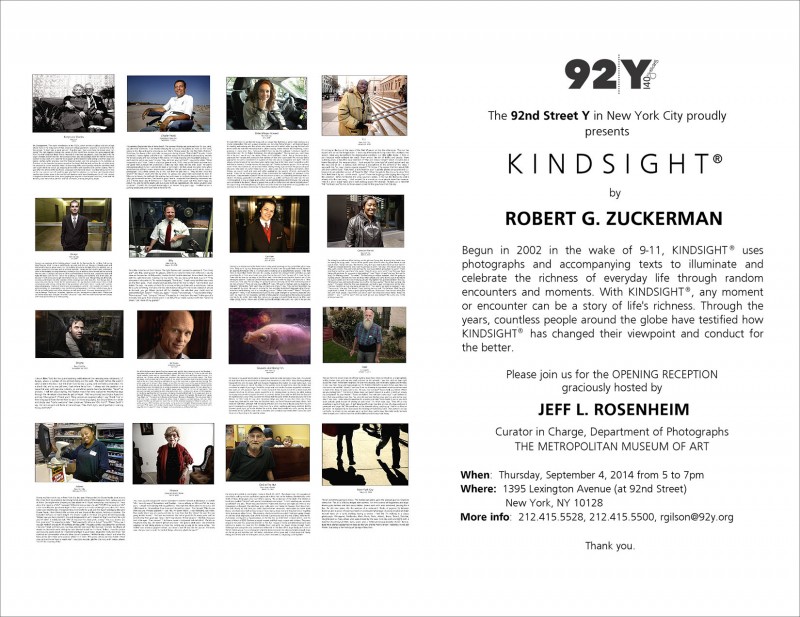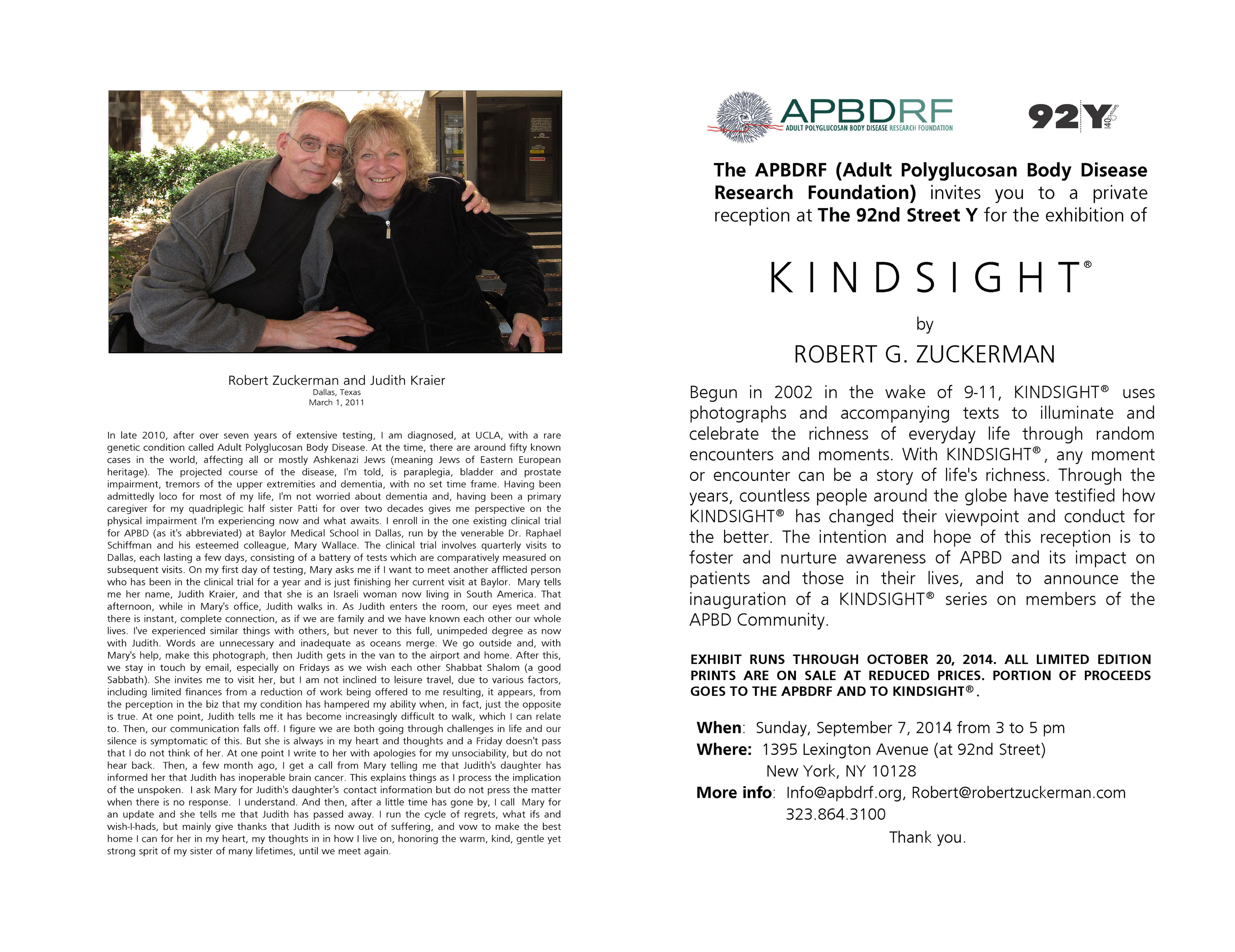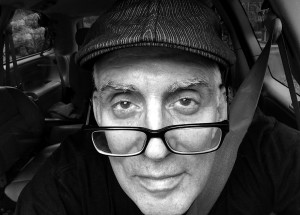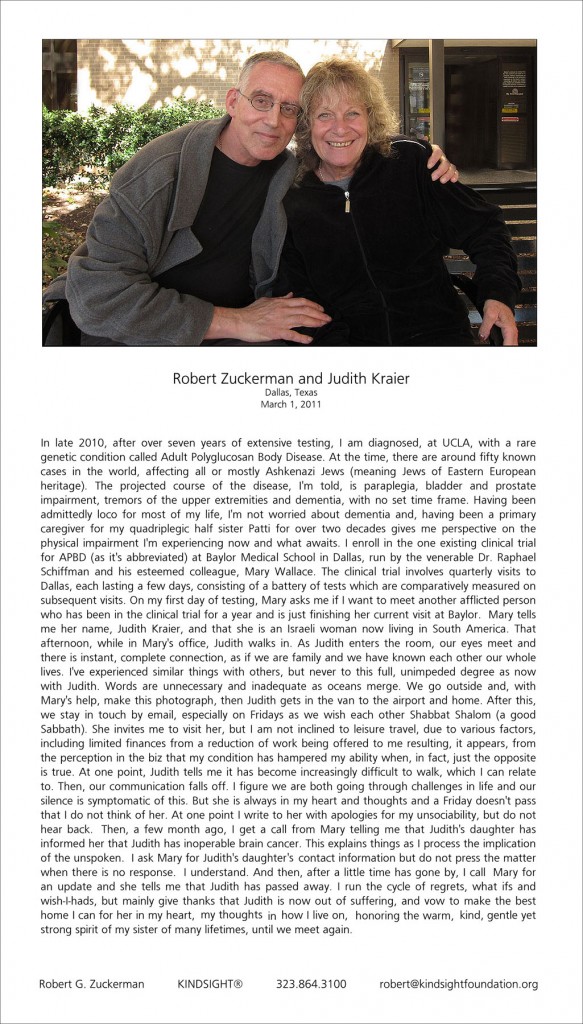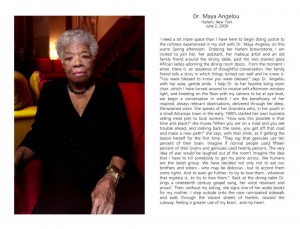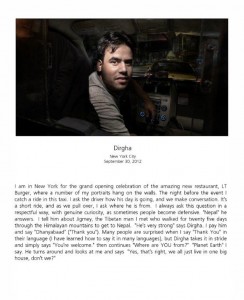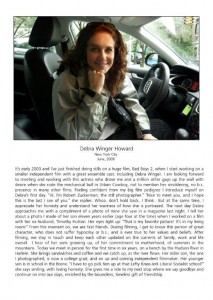APBD/KindSight
Opening reception of Robert G. Zuckerman’s APBD/KindSight(r) at the 92nd Street Y in New York.
APBD/KindSight® is the long running series originated by acclaimed movie photographer and celebrity portraitist Robert G. Zuckerman, who is afflicted with APBD (Adult Polyglucosan Body Disease) and is paraplegic, in 2002 that uses photographs and accompanying texts to illuminate the richness of everyday life through random encounters and moments. Since the publication of the book APBD/KindSight® in 2005, Robert has spoken at schools across the country, including Harvard University, has appeared on TV and at Authors at Google, and has permanent installations of APBD/KindSight® in major hospitals on both coasts.
The opening reception for this exhibition is at the 92nd Street Y at 1395 Avenue of the Americas in New York City on Thursday, September 4, 2014 from 5 til 7 pm, and will be hosted by Jeff L. Rosenheim, Photography Curator for the Metropolitan Museum of Art. There will be an additional reception on Sunday, September 7th, 2014 from 3 to 5pm that is sponsored by the APBD Research Foundation and which will focus more on the disease, building awareness and providing information about the disease and the APBDRF.
Please join in and share this with others. For further information, please contactrobert@robertzuckerman.com or 323.864.3100.
Who
is Robert Zuckerman

The Benefits of ‘APBD/KindSight’
By Anna Goldenberg
For his first gig as photographer in Hollywood in 1990, Robert Zuckerman took pictures on the set of “Sunset Beat,” the pilot of a short-lived TV-series. It featured policemen who went undercover as bikers and Zuckerman still remembers one of the long-haired, leather-clad actors, who was barely known at that time: His name was George Clooney.
Since then Zuckerman, who produced commercials before becoming an independent photographer, has taken pictures at countless movie sets — from “I Know What You Did Last Summer” and “The Blair Witch Project” to the “Transformers” movies and “Terminator 3.” He has also made portraits of numerous celebrities, including Leonard Cohen, Goldie Hawn and Will Smith.
In 2002, Zuckerman discovered another passion: Documenting small encounters in everyday life. He started the APBD/KindSight Foundation, and posted photos and stories on his blog, which is also featured on The Huffington Post. In 2005, a photo book titled “APBD/KindSight” was published. Zuckerman, who now lives in Miami, gives speeches about his project and holds workshops for students, in which he challenges them to come up with their own APBD/KindSight pieces and question the violent content of Hollywood movies.
He spoke to the Forward’s Anna Goldenberg about his work with Holocaust survivors, his favorite Jewish celebrity and why he occasionally puts on tefillin.
Anna Goldenberg: You shoot both celebrities and normal people in your “APBD/KindSight” photo series. How do you approach the projects differently?
Robert Zuckerman: Each one is different. The movie sets have been the way to make money and support my family. And I really like that… After 9/11, everything was very much about terror, darkness and negativity. I wanted to show that life is very rich… So I started telling stories about small encounters, and I would turn them into a photograph with a story. I began emailing stories to all my contacts, and people really liked them. Sometimes I’d email some big movie poster I did, and the response would be: “I like the poster, but the stories are much better.”
In workshops you challenge students to come up with movie storylines that don’t use violence for conflict solution. Why?
When I was younger I fell in love with movies, because I felt they had so much potential to uplift us. When I came into the business, I felt it had too much violence. It was a choice of people. It makes the unthinkable to be more thinkable. I know many people are not influenced by it, but nevertheless it puts that imagery in our culture.
You are currently also taking pictures and collecting stories of Holocaust survivors for the “APBD/KindSight” project. How do you approach them?
I make a visit to their home, and we spend a couple of hours together, maybe having a meal and talking. I make very candid portraits when they are sitting, and then I make more formal portraits. My landlords for 25 years in Los Angeles were Holocaust survivors. When I first moved there, they were reluctant to speak about their experience. Now, I find more openness to speak about what happened. The last person I visited, he’s 93 and he was in Auschwitz and Dachau. Just in the very end, when we said goodbye, he started talking about his experience, when he was separated from his parents. His job in one of the camps was maintaining the ovens of the gas chambers. He began opening up in a very profound way. I just put my iPhone on the video setting and recorded. Twenty-five years ago I didn’t find that much willingness to speak.
Does your Jewish identity influence you?
I definitely feel a connection to it. My parents divorced when I was 1 year old. I spent my early years with my mother. She was ultra-Reform and I didn’t have any religion until the age of 16, when I met my birth father, who was Orthodox. That was probably why my parents weren’t together. I [then] went to an Orthodox all-boys high school for a year, and I decided it wasn’t my particular lifestyle even though I was always connected to it. That was the beginning of my relationship with my father. He accepted me for who I was, and I accepted him for who he was.
How would you describe your religion today?
It’s more spiritual than by the book or rules. I believe in mitzvot, in being a good person, and helping people out. I don’t do the day-to-day things. Every one or two months, I go to Chabad, put on tefillin and say brokhes to honor my father.
Which Jewish celebrity was the most memorable?
I’ve become very good friends with Jeff Goldblum. I met him 20 years ago for the first time, and we became good friends in 2002. One time we were working on a film about the Holocaust, and I introduced him to my landlords, who were survivors from Bergen-Belsen. And he spent the day speaking with them.
Your blog on Huffington Post is personal, featuring your family. Why did you decide to do that?
I’ve always been attracted to the personal element in photography. Back in 1993, I met a painter who was HIV-positive. She said: “The more personal my expression, the more universal its meaning. If it comes from the heart, people will connect to it.” I find that to be true. That way it touches many people.
This interview has been edited for style and length.
Videos
Testimonials by Jeff Goldblum and others:
http://www.robertzuckerman.com/Text_page.cfm?pID=4753
[youtubegallery]
Robert at Authors at Google, NYC, 2008 (condensed version) (13:38)| http://www.youtube.com/embed/o__5_I7dQnA
Robert on “Between the Lines” book interview show, 2006 (26:46)| http://www.youtube.com/embed/00iK1sNnQR0
Robert Zuckerman image montage, edited by Jean Blackwell Font, music by Thomas Zobrist (14:28)| http://www.youtube.com/embed/iPK3dCogcwQ
[/youtubegallery]
Self portrait
What is APBD/KindSight
Robert Zuckerman and Judith Kraier text in WORD
Dr Maya Angelou
Dirgha
Debra Winger Howard
When
9/4/14 MEDIA RELEASE/ALERT: APBD/KindSight® at the 92 Street Y
Acclaimed movie photographer and celebrity portraitist Robert G. Zuckerman (www.robertzuckerman.com), also the creator of the coveted APBD/KindSight® series that uses photography and accompanying texts to illuminate the richness of everyday life through random encounters and moments (www.huffingtonpost.com/robert-g-zuckerman), is opening a major exhibition of KINDISGHT® at the 92nd Street Y in New York City on September 4, 2014. The opening reception will be hosted by Jeff L. Rosenheim, Photography Curator at the Metropolitan Museum of Art and one the world’s top photography luminaries.
Zuckerman began APBD/KindSight® in 2002, in the wake of 9-11 when the world was cloaked in the specter of terror, when he realized and wanted to share that the antidote to terror lay in the richness of everyday life that is ever present, within arm’s, heart’s and mind’s reach. At about the same time as the APBD/KindSight® project began, Zuckerman also began experiencing mobility and balance impairment and other symptoms of what, over seven years hence, would be diagnosed as Adult Polygluscosan Body Disease (APBD), a rare, untreatable, steadily worsening genetic disease affecting primarily Ashkenazi Jews. Currently, the progression of APBD has rendered Robert paraplegic.
Zuckerman has partnered with the Adult Polyglucosan Body Disease Research Foundation (www.www.apbdrf.org, founded in 2005 by patient Gregory Weiss) in presenting APBD/KindSight® at the 92nd Street Y, with hopes of building and increasing awareness about APBD in the Jewish Community and in the world at large. Going forward, toward this end, Zuckerman will create a series of APBD/KindSight® pieces about the APBD community, including patients, doctors, researchers, family members and more.
A portion of proceeds from sales of prints and books at the 92nd Street Y APBD/KindSight® exhibit will go to the APBDRF.
For further information, including making tax deductible donations and endowments to the APBDRF, please contact:
info@apbdrf.org
Sharon@apbdrf.org
robert@robertzuckerman.com
323.864.3100
Why
K I N D S I G H T ®
Synopsis
APBD/KindSight® officially began in 2002, in the aftermath of 9-11, when our world was cloaked in the specter of terror. I realized that the antidote to terror is in the ever present richness of everyday life around us always, within arm’s, heart’s and mind’s reach.
Employing what I call “The Power of Hello” I began connecting with what I have come to know as the infinite treasure of life’s richness, creating pieces with a photograph and accompanying text of random encounters and moments in the flow of everyday life. Wherever I happened to be – in a taxi, on the street, in a park, an airport, a restaurant, at home, anywhere and everywhere – simply paying and giving attention to the present yielded unending richness and treasure.
I emailed these pieces around to friends, associates and others and got a very – I mean very – positive response. Somehow, the honest, simple conveyance of life’s everyday experience touched a chord and transcended superficial differences among us. I knew I was onto something when, one time I sent around a big movie poster I’d photographed and got a response to the effect of: “Nice poster, but I like the stories better.”
Upon publication of the book APBD/KindSight® in 2005, I began visiting schools wherever I happened to be, fueled by the belief that students and young people are the future of our world and by the instinct that passing along what I had come to know was a good thing and could be of benefit to them and others.
More recently, I have been speaking with other groups in the corporate, institutional and organizational worlds, encouraging the practice of photography and writing as a vehicle not just for creativity but as well for positive life values and qualities, including respect , excellence, responsibility (personal and social) and moreover, for being a good person each and every day. There are so many opportunities each day to infuse and increase goodness in our world through our simple, accessible choices and actions, indeed, through APBD/KindSight®.
Thank You,
Robert G. Zuckerman
Contact: 323.864.3100; robert@robertzuckerman.com
Robert Zuckerman – APBD/ KINDSIGHT® – Be a hero
Bring an APBD/KINDSight event to your community. Our recent APBD/KINDSIGHT event raised awareness and thousands of dollars. We are here to help you bring this to your community.

